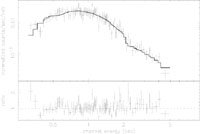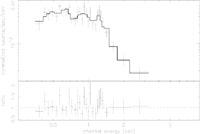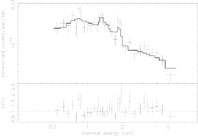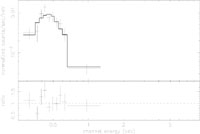


3.2. The nature of individual sources
In M83, detailed spectral analysis is possible for
sources with an emitted luminosity
 1038
erg s-1.
We can easily distinguish (Fig. 6):
1038
erg s-1.
We can easily distinguish (Fig. 6):
 2 × 1038 erg s-1; M ~ 107
M
2 × 1038 erg s-1; M ~ 107
M );
);
 1.3-1.7;
1.3-1.7;
 kT
kT
 1, plus a power
law of photon
index
1, plus a power
law of photon
index  2.2-3.0 (due to
Compton upscattering of the disk photons);
2.2-3.0 (due to
Compton upscattering of the disk photons);
 60 eV. They are
generally interpreted as accreting white dwarfs with stable nuclear
burning on their surface (see also
Di Stefano & Kong 2003).
60 eV. They are
generally interpreted as accreting white dwarfs with stable nuclear
burning on their surface (see also
Di Stefano & Kong 2003).
For a more extensive discussion of the spectral and temporal properties of the discrete sources in M83, see Soria & Wu (2003).
 |
 |
 |
 |
 |
 |
 |
 |
Figure 6. Spectral fits to a
sample of bright X-ray sources in M83 show different classes of objects. First three
rows, from top left:
the galactic nucleus; an X-ray binary in a hard state; an X-ray binary
in a soft state; a source with soft thermal plasma emission (a young
SNR?); a source with a power-law continuum plus line emission (from a
photo-ionized stellar wind?); a supersoft source. See
Soria & Wu (2003)
for further details on the sources and their fitted spectral
models. Bottom row: the brightest X-ray source in M83 has an emitted luminosity
in excess of 1039 erg s-1. A power-law spectral fit
gives a photon index 2.5 ± 0.1. Its lightcurve shows
an increase by
|
|
The brightest point source, located
 5' south-east
of the nucleus, is variable and has an emitted luminosity of
5' south-east
of the nucleus, is variable and has an emitted luminosity of
 1039
erg s-1 (Fig. 6, bottom panels).
Hence, it can be classified as an ultra-luminous source (ULX).
1039
erg s-1 (Fig. 6, bottom panels).
Hence, it can be classified as an ultra-luminous source (ULX).